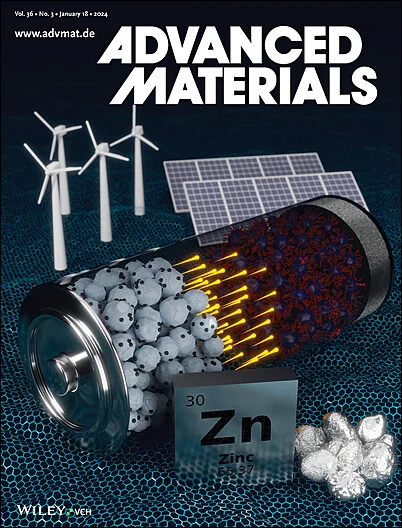A k Descriptor to Design of Current Collectors for Anode-Free Sodium Batteries.
IF 26.8
1区 材料科学
Q1 CHEMISTRY, MULTIDISCIPLINARY
引用次数: 0
Abstract
The anode-free strategy enables exceptionally high energy density in rechargeable metal batteries, but the lack of theoretical frameworks impedes current collector design. Here, this study mathematically derives three critical parameters: dielectric coefficient (ɛ), ion mobility (µ_C), and the change of concentration (δC_C), and introduces a quantitative descriptor, k, which serves as a benchmark for evaluating current collector efficiency. Experimentally, a carbon nanotube (CNT)-based current collector is fabricated with minimized ɛ, enhanced δC_C (nano/micro-Sb particles), and µ_C (sodium carboxymethylcellulose, CMC-Na). The optimized design achieves remarkable cycling stability-over 24 months at 0.25 mAh cm-2 and 0.5 mA cm-2, and 12 months even at a high areal capacity of 20 mAh cm-2. The lowest k value aligns with half-cell tests, validating this theory. This work establishes a quantitative framework for designing high-efficiency anode-free sodium battery current collectors.无阳极钠电池集流器设计的k描述符。
无阳极策略使可充电金属电池具有极高的能量密度,但缺乏理论框架阻碍了电流收集器的设计。本文从数学上推导了三个关键参数:介电系数(ε)、离子迁移率(µ_C)和浓度变化(δC_C),并引入了定量描述符k,作为评价集流效率的基准。实验制备了一种基于碳纳米管(CNT)的集流器,该集流器具有最小化的λ c_c(纳米/微sb粒子)和增强的µ_C(羧甲基纤维素钠,CMC-Na)。优化后的设计实现了卓越的循环稳定性-在0.25 mAh cm-2和0.5 mA cm-2下可超过24个月,即使在20 mAh cm-2的高面积容量下也可长达12个月。最低的k值与半电池测试一致,验证了这一理论。本研究为设计高效无阳极钠电池集流器建立了定量框架。
本文章由计算机程序翻译,如有差异,请以英文原文为准。
求助全文
约1分钟内获得全文
求助全文
来源期刊

Advanced Materials
工程技术-材料科学:综合
CiteScore
43.00
自引率
4.10%
发文量
2182
审稿时长
2 months
期刊介绍:
Advanced Materials, one of the world's most prestigious journals and the foundation of the Advanced portfolio, is the home of choice for best-in-class materials science for more than 30 years. Following this fast-growing and interdisciplinary field, we are considering and publishing the most important discoveries on any and all materials from materials scientists, chemists, physicists, engineers as well as health and life scientists and bringing you the latest results and trends in modern materials-related research every week.
 求助内容:
求助内容: 应助结果提醒方式:
应助结果提醒方式:


